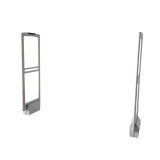In the evolving retail security services, the pursuit of providing a secure shopping environment harmonises with the rising emphasis on delivering an exceptional customer experience. Balancing robust security measures with a seamless and enjoyable shopping journey has become a critical focus for retailers worldwide. T
Retail security services encompass a spectrum of technologies and strategies, from Electronic Article Surveillance (EAS) systems to Radio-Frequency Identification (RFID) and innovative tagging solutions like Acoustic-Magnetic (AM) and Radio-Frequency (RF) labels. These tools are at the forefront against theft and inventory shrinkage while shaping a shopping atmosphere that promotes trust, convenience, and a positive customer experience.
The Significance of Retail Security Services in Businesses
In the contemporary retail landscape, the significance of robust security services transcends mere merchandise protection; it stands as a linchpin for businesses, fostering trust, stability, and sustained growth. This section delves into the multifaceted importance of retail security services and their pivotal role in shaping businesses:

1. Safeguarding Assets and Reducing Losses:
- Protection Against Theft: Retail security services, including Electronic Article Surveillance (EAS) systems, AM/RF labels, and RFID technology, are formidable deterrents against shoplifting and internal theft, mitigating losses and preserving profit margins.
- Minimization of Inventory Shrinkage: By implementing comprehensive security measures, businesses effectively curtail inventory shrinkage, safeguarding valuable assets.
2. Upholding Reputation and Trust:
- Customer Confidence: A secure shopping environment instils customer confidence, fostering trust in the brand and encouraging repeat visits and customer loyalty.
- Brand Image Enhancement: Robust security measures convey a commitment to customer safety, enhancing the brand’s reputation and credibility.
3. Legal and Compliance Requirements:
- Adherence to Regulations: Retail security services aid businesses in complying with legal requirements and industry standards, mitigating risks associated with non-compliance and potential legal repercussions.
4. Operational Efficiency and Cost Reduction:
- Streamlined Operations: Efficient security measures, such as integrating EAS and RFID technologies, facilitate smoother operations, optimize inventory management, and reduce operational complexities.
- Cost Savings: Prevention of theft and shrinkage leads to substantial savings for businesses, directly impacting their bottom line and overall profitability.
5. Enhancing Customer Experience:
- Seamless Shopping Experience: Well-implemented security measures, while ensuring protection, are designed to be minimally intrusive, preserving a positive and hassle-free shopping experience for customers.
6. Prevention of External Threats:
- External Security Threat Mitigation: Beyond theft prevention, retail security services also address external threats such as vandalism, ensuring the safety and security of both merchandise and customers.
Essential Components of Retail Security Services
Retail security services rely on essential components and technologies that form the backbone of effective merchandise protection and risk mitigation strategies. This section elucidates the fundamental elements integral to robust retail security services:
1. Electronic Article Surveillance (EAS) Systems:
- Overview: EAS systems encompass a range of technologies utilizing tags, labels, and detection systems to deter theft.
- Role: EAS systems consist of tags (hard, soft, or labels) attached to merchandise, triggering alarms if not deactivated or removed properly at the store exit.
2. Acoustic-Magnetic (AM) and Radio-Frequency (RF) Labels:
- Functionality: AM and RF labels are covert anti-theft measures applied directly to merchandise or packaging.
- Detection: These labels interact with antennas at store exits, triggering alarms if not deactivated or detached through authorized means.
3. Tagging Solutions: Hard Tags, Soft Tags, and Labels:
- Hard Tags: Rigid, durable tags attached to items using pins or lanyards, providing a visible deterrent against theft.
- Soft Tags: Flexible tags made of plastic or paper-like material, applied using adhesive backing, ensuring protection without damaging merchandise.
- Labels: Thin, adhesive-backed tags like RFID or barcode labels directly affixed to items or packaging.
4. Radio-Frequency Identification (RFID) Technology:
- Overview: RFID technology utilizes electromagnetic fields to identify and track tags attached to merchandise automatically.
- Role: RFID enhances inventory management, efficiently tracking items throughout the supply chain and within the store.
5. Surveillance Systems and Security Cameras:
- Functionality: Surveillance cameras act as visual deterrents and aid in monitoring store activity, deterring theft and providing evidence in case of incidents.
6. Access Control Measures:
- Keyless Entry Systems: Electronic access control systems limit unauthorized access to sensitive areas, ensuring restricted entry based on authorization levels.
7. Integration with Point-of-Sale (POS) Systems:
- Seamless Integration: Linking security systems with POS technologies ensures automatic deactivation of security measures upon legitimate purchases, enhancing the shopping experience.
Innovations in Retail Security for Improved Customer Experience
In the pursuit of enhancing the retail security landscape for a more seamless and customer-friendly shopping experience, various innovations have emerged, transforming how businesses protect their merchandise while prioritizing customer satisfaction.
1. Evolution of EAS Systems:
- Advanced and User-Friendly Designs: EAS systems have shifted towards user-friendly interfaces and streamlined designs, ensuring better integration into diverse retail environments.
2. Integration of AI and IoT:
- Predictive Analytics and Behavioral Analysis: Utilizing Artificial Intelligence (AI) and the Internet of Things (IoT), modern security solutions leverage predictive analytics and behavioural analysis to preempt potential threats, proactively enhancing security without disrupting customers.
3. Customer-Centric Design:
- Balancing Protection with Experience: Security products now focus on maintaining a delicate equilibrium between robust merchandise protection and a non-intrusive shopping experience, prioritizing customer satisfaction.
4. Eco-Friendly and Sustainable Solutions:
- Sustainability in Security: The emphasis on eco-friendly designs and sustainable practices within security solutions aligns with broader environmental initiatives without compromising security standards.
5. Seamless Integration with Retail Operations:
- Automated Deactivation: Solutions that seamlessly integrate with Point-of-Sale (POS) systems and other retail operations ensure hassle-free deactivation of security measures post-legitimate purchases, fostering a smoother customer journey.
In this era of innovative strides in retail security, manufacturers like Asecuri have been at the forefront, championing advancements aimed at fortifying protection while enhancing customer experiences. Their commitment to sustainability, seamless integration, and customer-centric security solutions encapsulates the industry’s drive towards a secure, shopper-friendly retail landscape.

Best Practices for Retailers
Implementing effective retail security services involves a strategic approach beyond installing systems and technologies. This section explores the best practices that retailers can adopt to ensure comprehensive merchandise protection while prioritizing customer satisfaction:
1. Tailoring Security Measures to Customer Needs:
- Understanding Customer Preferences: Retailers should assess and align security measures with customer expectations, ensuring a secure environment without causing inconvenience or disruption to their shopping experience.
2. Creating a Safe and Welcoming Environment:
- Balancing Security and Ambiance: Implementing retail security services discreetly while maintaining a welcoming and comfortable atmosphere fosters a sense of safety among customers without feeling intrusive.
3. Feedback and Adaptation:
- Listening to Customer Input: Encouraging customer feedback about their security experiences enables retailers to adapt and fine-tune security protocols, addressing concerns and improving overall satisfaction.
4. Comprehensive Employee Training:
- Training in Security Protocols: Educating and training staff on security procedures, theft prevention, and customer interaction during security checks ensures a consistent and professional approach to maintaining security without causing discomfort.
5. Integration of Security with Operational Processes:
- Seamless Integration: Integrating security systems with POS operations and inventory management streamlines processes, ensuring that security measures are seamlessly applied and deactivated upon valid transactions.
6. Continuous Monitoring and Adaptation:
- Regular Assessments: Conducting periodic evaluations and risk assessments of existing security measures allows retailers to adapt to evolving threats and technological advancements.
7. Collaborative Approach to Security:
- Engaging Security Professionals: Collaboration with security experts or professional services allows for implementing tailored security solutions aligned with industry best practices.
Conclusion
In stores and shopping, keeping things safe and making customers happy is super important. That’s where good security in shops comes into play! Balancing how to protect things from getting stolen and ensuring customers feel good while they shop is a big deal.
By using smart technologies like alarms and tags on products, shops can stop things from being taken without permission. But it’s not just about having fancy gadgets. Shops also need to think about what customers want. They should make sure security measures don’t bother customers too much and make them feel safe at the same time.
So, in the end, it’s about finding that sweet spot between having strong security and making sure customers have a great time shopping. When shops do this well—using cool technology, listening to customers, and making security easy—everyone wins! Customers feel safe, and shops can protect their things while ensuring people return for happier shopping experiences.


































